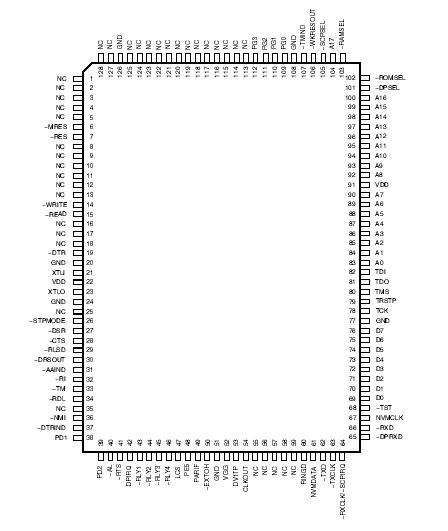Features: • V.90 data/V.17 fax modem
• SmartDAA technology
− System side powered DAA operates under poor line current supply conditions
− Wake-on-ring
− Ring detection
− Line polarity reversal detection
− Line current loss detection
− Pulse dialing
− Call waiting detection
− Digital PBX line protection
− Meets world-wide DC VI Masks requirements
− Caller ID detection
• Data/Fax/Voice call discrimination
• Hardware-based modem controller
• Hardware-based digital signal processor (DSP)
• Voice/full-duplex speakerphone mode (S models)
• V.70 DSVD using optional RCDSVD SCP (S models)
• World-wide operation
• Industry standard communication commands
• Selectable parallel/serial interface with speeds up to 230.4 kbps
− Parallel 16550A UART-compatible interface
− Serial ITU-T V.24 (EIA/TIA-232-E)
• V.80 synchronous access mode
• Direct mode (serial interface)
• Synchronous data mode (serial interface)
• V.22 bis fast connect
• Analog cellular direct connect
• GSM direct connect
• Sleep mode
• Thin packages support low profile designs
• +3.3V operation with +5V tolerant digital inputsApplication• PC Cards
• Embedded systems
• Serial box modems
• Set top boxes
• Point of sales terminals
• Remote monitoring and data collection systemsPinout Specifications
Specifications Description
DescriptionThe SmartACFL device L2702 set, comprised of separate microcontroller (MCU), modem data pump (MDP), and line side device (LSD) devices, provides the processing core for a complete modem design. The optional Voice Codec (VC) supports voice/full-duplex speakerphone (FDSP) operation with interfaces to a microphone and speaker and to a telephone handset/headset (S models). The S model L2702 can also be ordered with an RCDSVD Speech Codec Processor (SCP) in a 100-pin PQFP to support DSVD.
Modem operation, including dialing, call progress, telephone line interface, telephone handset interface, voice/speakerphone interface, and host interface functions are supported and controlled through the V.250, V.251, and V.253-compatible command set.
The modem hardware L2702 connects to the host via a parallel, serial, or PC Card interface. The OEM adds discrete components as required by the modem model and the application to complete the system (Table 1). These components may include a crystal circuit, EEPROM, DIB components, telephone line interface, optional voice/speakerphone interface, and optional cellular/GSM interface.
Parallel interface operation, including cellular and GSM support, is selected by PARIF input high. Serial interface operation is selected by PARIF input low. Cellular operation is selected by LINE/CELL input low. GSM operation is selected by LINE/GSM input low.

 L2702 Data Sheet
L2702 Data Sheet








